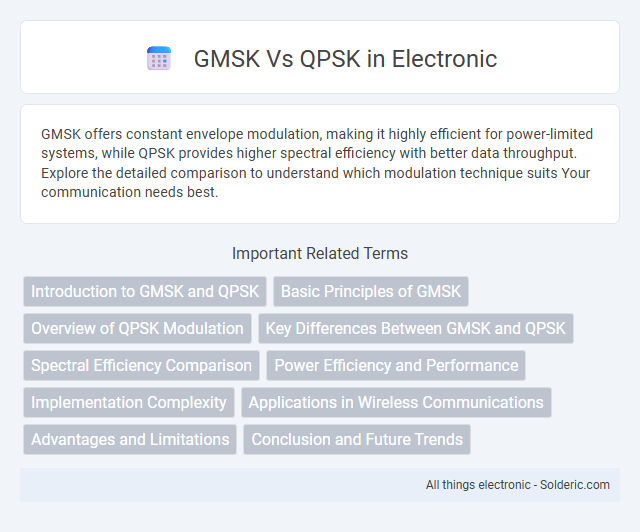GMSK offers constant envelope modulation, making it highly efficient for power-limited systems, while QPSK provides higher spectral efficiency with better data throughput. Explore the detailed comparison to understand which modulation technique suits Your communication needs best.
Comparison Table
| Parameter | GMSK (Gaussian Minimum Shift Keying) | QPSK (Quadrature Phase Shift Keying) |
|---|---|---|
| Modulation Type | Continuous-phase frequency shift keying | Phase modulation with four distinct phase shifts |
| Spectral Efficiency | High, due to Gaussian filtering | High, supports 2 bits per symbol |
| Bandwidth | Narrow bandwidth, controlled by Gaussian filter | Wider bandwidth compared to GMSK |
| Power Efficiency | Moderate, constant envelope allows efficient power amplifiers | Moderate, requires linear amplification |
| Complexity | Lower complexity, simpler demodulation | Higher complexity, requires coherent detection |
| Applications | GSM mobile communications | Wi-Fi, LTE, satellite communications |
| Bit Error Rate (BER) | Better performance in AWGN channels | Comparable BER but sensitive to phase noise |
| Signal Characteristics | Constant envelope, reduced spectral sidelobes | Phase shifts cause signal envelope variation |
Introduction to GMSK and QPSK
GMSK (Gaussian Minimum Shift Keying) is a continuous-phase frequency shift keying technique known for its spectral efficiency and reduced out-of-band emissions, essential in GSM mobile communications. QPSK (Quadrature Phase Shift Keying) transmits data by changing the phase of the carrier signal in four distinct states, doubling the data rate compared to BPSK while maintaining robustness. Your choice between GMSK and QPSK impacts system bandwidth, power efficiency, and complexity, depending on communication requirements.
Basic Principles of GMSK
GMSK (Gaussian Minimum Shift Keying) modulates digital signals using continuous-phase frequency shifts shaped by a Gaussian filter, significantly reducing spectral bandwidth and interference. This modulation method leverages minimum frequency shifts to maintain phase continuity, enhancing signal robustness in mobile communications. Your choice of GMSK ensures efficient bandwidth utilization and improved performance in fading environments compared to QPSK.
Overview of QPSK Modulation
QPSK (Quadrature Phase Shift Keying) modulation encodes data by shifting the phase of the carrier signal in four distinct states, allowing two bits per symbol to be transmitted efficiently. Compared to GMSK (Gaussian Minimum Shift Keying), QPSK offers higher spectral efficiency and better data rates, making it suitable for applications like LTE and Wi-Fi. Your system can benefit from QPSK's robustness in noisy channels and improved bandwidth utilization for enhanced communication performance.
Key Differences Between GMSK and QPSK
GMSK (Gaussian Minimum Shift Keying) employs continuous phase modulation with a Gaussian filter to reduce bandwidth and minimize interference, making it highly power-efficient for mobile communications. QPSK (Quadrature Phase Shift Keying) transmits two bits per symbol using four distinct phase shifts, enabling higher data rates but typically requiring more linear amplification. GMSK's constant envelope modulation contrasts with QPSK's variable envelope, impacting amplifier design and signal robustness in fading channels.
Spectral Efficiency Comparison
GMSK offers moderate spectral efficiency due to its continuous-phase modulation, reducing bandwidth while maintaining signal integrity, commonly used in GSM systems. QPSK provides higher spectral efficiency by encoding two bits per symbol, effectively doubling data throughput within the same bandwidth compared to BPSK. Despite GMSK's robustness against interference, QPSK's capability to transmit more bits per Hz makes it preferable for high-data-rate applications requiring compact spectral use.
Power Efficiency and Performance
GMSK (Gaussian Minimum Shift Keying) offers superior power efficiency due to its constant envelope, minimizing nonlinear distortion and enabling use of power-efficient amplifiers, which is critical for battery-powered devices. QPSK (Quadrature Phase Shift Keying) provides higher spectral efficiency and better performance in noise-limited environments but requires more linear power amplifiers, leading to increased power consumption. Your choice should balance power constraints with performance needs, especially in wireless communication systems where energy efficiency and signal robustness are key factors.
Implementation Complexity
GMSK (Gaussian Minimum Shift Keying) requires more complex modulation and demodulation schemes due to its continuous-phase nature and the need for pulse shaping with a Gaussian filter, increasing implementation complexity compared to QPSK (Quadrature Phase Shift Keying). QPSK benefits from simpler baseband processing as it directly modulates phase states without continuous phase constraints, leading to reduced hardware complexity and easier digital signal processing. The trade-off in implementation complexity makes QPSK more suited for cost-sensitive applications, while GMSK's complexity is justified in systems requiring better spectral efficiency and power efficiency.
Applications in Wireless Communications
GMSK is widely used in GSM cellular networks due to its spectral efficiency and constant envelope properties, making it suitable for power-limited mobile devices. QPSK is preferred in WLANs, satellite communications, and LTE systems for its higher data rate capabilities and robustness in multipath environments. Your choice between GMSK and QPSK depends on application requirements such as bandwidth efficiency and signal power constraints in wireless communication systems.
Advantages and Limitations
GMSK offers high spectral efficiency and constant envelope modulation, making it highly resistant to non-linear distortion and ideal for mobile communication systems like GSM. QPSK provides higher data rates with better bandwidth utilization, enabling more complex data transmission but requires linear amplification and is more sensitive to phase noise. Understanding these trade-offs helps optimize Your system design for either robustness in noisy environments with GMSK or higher throughput with QPSK.
Conclusion and Future Trends
GMSK offers superior spectral efficiency and reduced interference, making it ideal for mobile communications, while QPSK provides higher data rates with improved robustness in multipath environments. Emerging trends indicate a shift towards hybrid modulation schemes that combine GMSK's power efficiency with QPSK's throughput advantages to meet the demands of 5G and beyond. Your choice should consider system requirements such as bandwidth constraints and error performance, aligning with the evolving landscape of wireless technology.
GMSK vs QPSK Infographic

 solderic.com
solderic.com